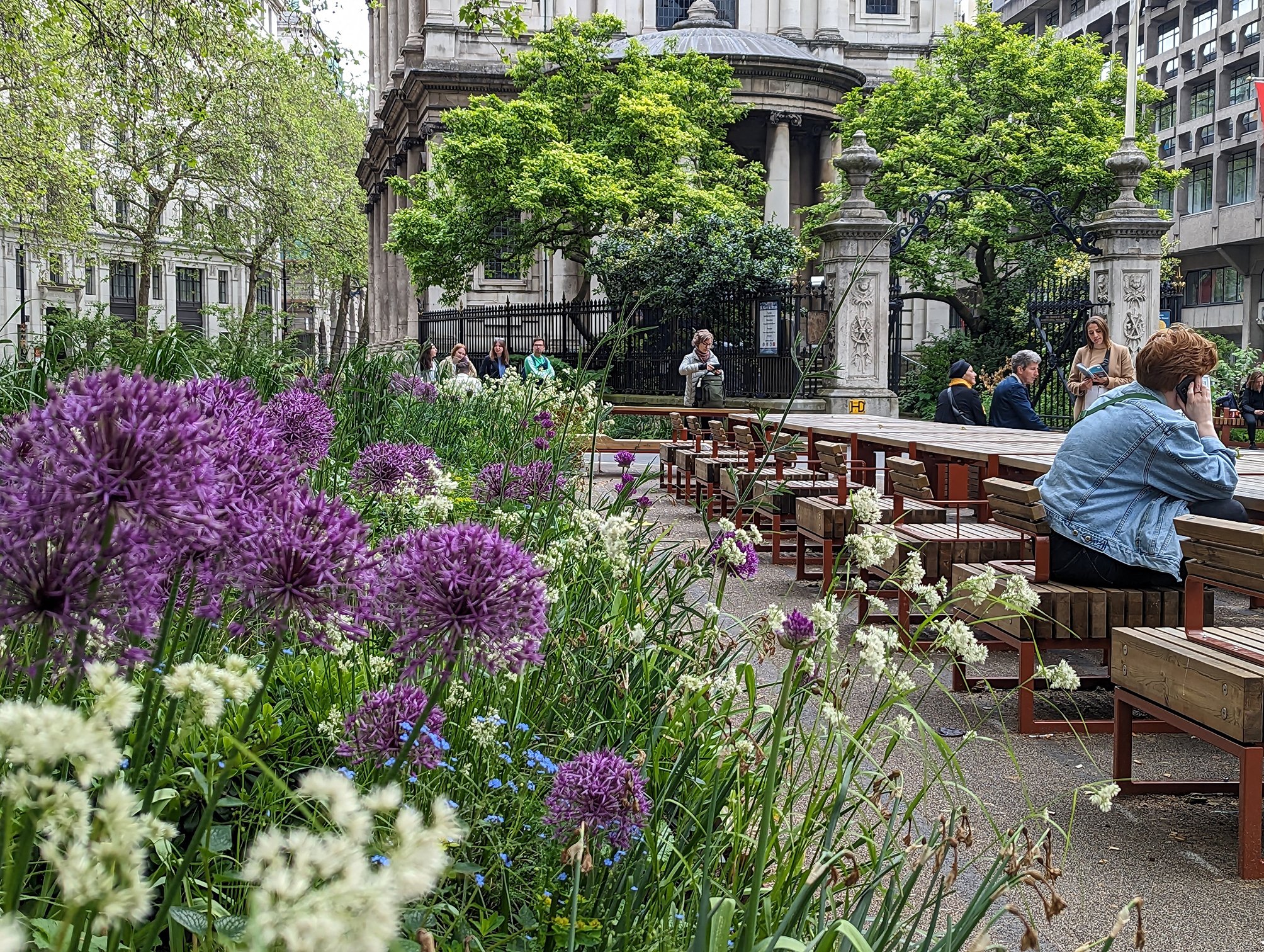Strand, Aldwych
Purple and white flowers among green grasses beside a hard-landscaped area with people sitting around and standing near large tables and chairs outside a church.
Designer: LDA Design
Client: Westminster City Council
Withernay Projects provided inclusive design consultancy for the re-imagining of Strand in London, which includes the creation of a sanctuary garden around St Mary-le-Strand Church.
The scheme was highly commended in the AJ Architecture Awards 2023 in the Landscape and Public Realm Project category and won a Civic Trust Award in 2024.
Holborn House
Artist Caragh Thuring created an etched artwork featuring the shapes of local brickwork inscribed with words and phrases that transparently covers the glass facade of Holborn House.
Architect: 6a architects
Artist: Caragh Thuring
Client: Holborn Community Association
Artist Caragh Thuring worked with 6a architects to transform the longstanding community centre into a modern, accessible and welcoming venue in a refurbishment project called Great Things Lie Ahead 2020. The completed project was highly commended for the Selwyn Goldsmith Award for Universal Design in 2023. The project also won an RIBA National Award and RIBA London Award in 2023.
Canolfan Ucheldre
Red fabric upholstered audience seating arranged in tiers seen from the stage between white stone walls with arched openings. Steps on the right of the seats lead up to twelve rows of seats.
Architect: De Matos Ryan
Client: Canolfan Ucheldre
Canolfan Ucheldre is an arts centre and theatre occupying the former chapel of a convent school in Holyhead on Holy Island. ‘Canolfan Ucheldre’ translated from Welsh means ‘High Town Centre'.
A community group that had previously campaigned to conserve the convent building reconvened to adapt the building into a theatre and arts centre that first opened to the public in June 1991.
Withernay Projects carried out an access audit, advised the design team about maximising inclusion within the available budget and produced an Inclusive Design Statement in early 2021. Currently on site.
Skinners’ Hall
Interior of Skinners’ Hall. A grand room with orange / red walls and white picture rail, skirting and window architrave. Portraits of men are on either side of a three-bay floor to ceiling window. The central bay of the window is arched. A long chain hangs down the centre of the image suspending a chandelier into the room below, through a large, circular void in the floor.
Architect: 6a architects
Client: Pellipar Services Company Limited
Skinner’s Hall is a Grade I listed Scheduled Monument dating from the sixteenth century, located in the City of London. The Worshipful Company of Skinners has occupied buildings on the site since the mid 17th century but the organisation dates back to the thirteenth century. The original Skinners’ Hall was destroyed during the Great Fire of London in 1666 and parts of it were built shortly afterwards.
Now under construction, the works involve removal of unsympathetic 1980s additions to upper levels, modification of the entrance courtyard to provide step-free, inclusive access, refurbishment of the historic vaulted cellars to create a function hall and associated facilities, and sensitive refurbishment throughout.
Withernay Projects completed an access audit of the existing building, inclusive design statement in support of the planning and listed building applications and continues to advise the design team throughout the on-site works.
Camden People’s Theatre
Corner of the Camden People’s Theatre prior to the works, looking up. A painted sign with the text ‘CPT New adventures in theatre’ is in yellow on a deep red background above a disused door on the corner of the building. Either side of this are burgundy-red glazed tiles topped by orange tiles. A green sign with the building number ‘60’ is above the red sign. The partially seen building above in painted off-white.
Architect: De Matos Ryan
Client: Camden People’s Theatre
The Camden People’s Theatre on Hampstead Road has occupied a former public house (The Lord Palmerston) in the London Borough of Camden since 1994 and has become an important cultural asset to the local community since then.
Withernay Projects has worked with the design team and client to make more efficient use of its available space and bring the building up to date with current expectations for performance venues to ensure its future and help its growth. The theatre re-opened in June 2021.
Young V&A
Interior of the Young V&A at Bethnal Green in London with a pink-painted display case on the right, pink and purple wallpaper with framed pictures on the left and a black & white chequered floor leading into the Ames room ahead.
Architect: De Matos Ryan
Client: V&A
The Young V&A (formerly the V&A Bethnal Green Museum of Childhood) reopened in June 2023 as a more child-focused, inclusive environment suitable for the anticipated increase in visitors and expectations for venues of this type.
Withernay Projects has worked with the team from the beginning of the successful competition process and throughout construction. Young V&A reopened in summer 2023.
Lakeside Centre Thamesmead
Pigeons outside the Lakeside Centre in November 2018 prior to the building’s transformation.
Architect: Architecture 00
Client: Bow Arts Trust
Completed in 2019, the project transformed the Brutalist Lakeside Centre building into 38 new affordable creative workspaces, a cafe, training kitchen, facilities for boating activities and an early years day nursery.
Wyeside Arts Centre
The rear of the Wyeside Arts Centre seen from the adjacent bridge over the River Wye.
Architect: De Matos Ryan
Client: Wyeside Arts Centre
The Grade II listed Building now known as Wyeside Arts Centre was originally constructed on the bank of the River Wye in Builth Wells in 1877 as a market hall, assembly rooms, public library and labour exchange. The building was adapted to become the Wyeside Arts Centre in 1978.
Withernay Projects worked with De Matos Ryan on a feasibility study to upgrade, extend and adapt the building to make it accessible and more suited for contemporary cultural events.
Hornsey Town Hall
Art deco balustrade in Hornsey Town Hall.
Architect: Make
Client: Far East Consortium
Hornsey Town Hall is a 1930s civic building in the London Borough of Haringey. The Grade II* listed building has been largely disused since 2004. The proposed restoration and refurbishment (designed by Make Architects) comprises an arts centre, 67 room hotel, 146 new residential units, works to the public realm, including the forecourt of the Town Hall, cafe; flexible community spaces; and co-working spaces. The arts centre includes the large theatre and two cinemas.
Hanover Square
Hanover Square in May 2016. © Rachael Marshall 2016.
Architect: Publica.
Client: Westminster City Council
Public realm proposal for the gardens, and pedestrian, motor and cycle routes for a historic square in central London. The proposals incorporate the approach to the new Bond Street (East) Elizabeth Line station.
Withernay Projects has advised the design team about access and inclusion throughout the early stages of developing the proposals.
Kettner's Townhouse, Westminster
Early twentieth century canopy to Kettner's on Romilly Street in Soho. © Rachael Marshall 2014.
Architect: Soda.
Client: Soho Estates.
Withernay Projects worked with Soho Estates and Soda. to prepare a planning application for the Kettner's Townhouse site in Soho. The large and complex site comprises fifteen adjoined and interlinked buildings, eleven of which are Grade II listed.
The proposed development will provide step-free accommodation to Soho House Private Members' Club for the first time in its existence, and significantly improved access to the Kettner's parts of the buildings. The ground floor restaurant will be refurbished and 28 new guest rooms will be created on the upper storeys, including five accessible rooms.
MK Gallery, Milton Keynes
MK Gallery, Milton Keynes. © Rachael Marshall 2014.
Architect: 6a Architects.
Client: MK Gallery
Withernay Projects provided an access audit report of the existing access provision and proposed access strategy in support of the MK Gallery's Arts Council England funding application.












